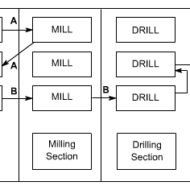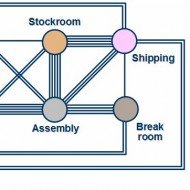Currently Browsing: Operations Management
Posted by Managementguru in Business Management, How To, Marketing, Operations Management, Productivity, Project Management, Sales
on Feb 2nd, 2021 | 0 comments

One of the most important features of your business is your stock. Without any stock, you can’t fulfill any sales and therefore you won’t be able to make any money. That’s why it’s always good to keep on top of your company’s stock, to make sure you have enough to sell but not too much that you might end up throwing away. With this in mind, here are some ways in which you can achieve optimum stock levels in your business. Keep the room tidy One of the best ways in which to keep on top of your company’s stock is being able to make sure you can access any product you need at all times. To start with, you should install lots of shelving to make the most out of any space you have. Try and group your products into different categories; for example, if you sell clothes these could be grouped into different garment types such as tops, skirts, or shoes. Once you’ve organized your stock room, it’s important to keep it organized at all times. When you restock the shelves or add new lines of stock, it’s important that you keep to the same system. It’s also important that you keep this room clean and tidy, so there are no obstacles getting in the way of you and your stock. One of the major problems that could obstruct your ability to do this is all the cardboard and plastic packaging that all of your stock will be delivered in. Once these boxes are opened to gain access to your stock, it’s important that the packaging is disposed of in an equally organized manor. The best way to do this is with recycling baler machines, which not only reduce the size of the waste but compact it into one manageable bale. Without this, you could either end up with a large recycling bin in your stock room, or even worse—lots of unwanted cardboard left on the floor or the shelves. Try to predict trends When you’re trying to predict how much stock you’ll need in order to get through a certain sales period, it’s important to recognize any trends you’ve previously had throughout your years of selling. For example, if you’re a garden center you’ll probably sell lots of outdoor furniture in the summer months but less in the winter months. The opposite would be true for Christmas trees. Some trends will be a lot less obvious than these examples, so make sure you review all of the information to make sure you’re increasing your stock levels at the right times. That way, you’ll know you won’t run out of a particular product at the specific time that everyone wants to buy it. Check the real stock levels against the calculated ones It’s highly likely that you’ll keep track of your stock by updating a spreadsheet when you buy new products and when you sell them. Whilst this is an efficient way of keeping track of your stock, it might not always be entirely accurate. It’s important to regularly check your stock numbers manually and correct any incorrect data on the spreadsheet. Issues such as stock getting damaged or lost, or even a typo on the document could all result in incorrect calculations compared to your actual stock, which could lead to confusion when you go looking for stock that might not actually...

Posted by Managementguru in Business Management, Employee Safety, Human Resource, Operations Management, Productivity, Project Management
on Sep 17th, 2020 | 0 comments

You’re probably not losing any sleep over facility management if your business fits into one small office. But, if you plan on growing your business, your small office will eventually grow into a whole building. This is where facility management comes in. The job of a facility manager is to ensure a well-organized environment in which you, your team, and your whole business can thrive. According to Transparency Market Research, the North American facilities management market will be worth about $340 billion by the end of 2024. So, facility management services are not something you should underestimate. Read on : Optimoroute has come out with a resourceful article on Route Optimization Software that sheds light on creating efficient transport plans using app or software to cut costs, save time, and utilize resources.Why Use Route Optimization Software? The Basics of Facility Management Facility management is a profession that focuses on utilizing a company’s buildings and equipment in a way that offers the best value. Facility maintenance is just one part of facility management. Strategic facility management ensures functionality, productivity, and safety in the built environment. Facility management is also key to ensuring that your company’s buildings and equipment comply with existing legal requirements. If you are wondering if or when you should hire a facility manager, here are some telltale signs: Your Maintenance Costs Are Escalating As your business grows, so will your maintenance costs. But, if these costs start running down your company, you have a problem. Some common money-wasters are likely to blame If you can’t figure out why your servicing and repair costs are increasing each month. These can include unused office space, wasteful stocking of spare parts and inventory, and under-utilisation or abuse of existing equipment. According to a 2013 report published by Wired, the U.S. had added about 2 billion sq. ft. of office space to its existing stock over the previous 30 years. Today’s mobile workforce doesn’t require so much space. The way you manage maintenance personnel and other staffing expenses also has an impact on your bottom line. The costs quickly pile up if you frequently have to call in heating engineers, electricians, plumbers, and other contractors. When you are operating in multiple locations, or have a very large facility, it’s hard to keep track of all maintenance tasks. Many business owners are in the habit of tracking everything manually. This can get messy really quickly. Moreover, if this is something you don’t have experience with, you can’t know whether the maintenance workers are carrying out their tasks properly. This is why facility managers rely on facility management software. Such tools allow them to make sure that every contractor and maintenance employee is doing the work they are being paid for. You Need to Expand Your Facilities to Accommodate Growth Let’s say that your business is expanding and you need additional storage space for your data. To handle the growing needs of your company, you need to build an effective data centre infrastructure. Naturally, this is a huge investment, and you don’t want to bite off more than you can chew. A facility manager can help make sure your new data centre can handle the evolution of your company. Using their experience, they can vet and hire a data centre construction firm. Their job would also be to manage the service contract you have with the firm, help ensure data centre security, and manage periodic upgrades. Even though your facility manager may not be an authority on the subject, they will know how to find and work with people who are. A good facility manager knows how to take care of quality control when engaging...

Posted by Managementguru in Operations Management, Principles of Management
on Jul 8th, 2017 | 0 comments

Types of Plant Layout Layouts can be classified into the following categories: Process Layout Product Layout Fixed Position Layout Combination Layout Group Layout Become a Product Manager | Learn the Skills & Get the Job The most complete course available on Product Management. 13+ hours of videos, activities, interviews, & more Process Layout Process layouts are found primarily in job shops, or firms that manufacture customized, low-volume products that may require different processing requirements and sequences of operations. Process layouts are facility configurations in which operations of a similar nature or function are grouped together. As such, they occasionally are referred to as functional layouts. Their purpose is to process goods or provide services that involve a variety of processing requirements. Process layouts are also quite common in non-manufacturing environments. Examples include hospitals, colleges, banks, auto repair shops, and public libraries. Process Layout Advantages: Better machine utilization Highly flexible in allocating personnel and equipment because general purpose machines are used. Diversity of tasks for personnel Greater incentives to individual worker Change in Product design and process design can be incorporated easily More continuity of production in unforeseen conditions like breakdown, shortages, absenteeism Process Layout Disadvantages: Increased material handling Increased work in process Longer production lines Critical delays can occur if the part obtained from previous operation is faulty Routing and scheduling pose continual challenges This is a typical store layout of Walmart: Product Layout Product layouts are found in flow shops (repetitive assembly and process or continuous flow industries). Flow shops produce high-volume, highly standardized products that require highly standardized, repetitive processes. In a product layout, resources are arranged sequentially, based on the routing of the products. This type of layout is generally used in systems where a product has to be manufactured or assembled in large quantities. In product layout the machinery and auxiliary services are located according to the processing sequence of the product without any buffer storage within the line itself. Plant Layout of Coca-Cola: Product Layout Advantages: Low material handling cost per unit Less work in process Total production time per unit is short Low unit cost due to high volume Less skill is required for personnel Smooth, simple, logical, and direct flow Inspection can be reduced Delays are reduced Effective supervision and control Product Layout Disadvantages: Machine stoppage stops the line Product design change or process change causes the layout to become obsolete Slowest station paces the line Higher equipment investment usually results Less machine utilization Less flexible Two types of lines are used in product layouts: paced and unpaced. Paced Lines: Paced lines can use some sort of conveyor that moves output along at a continuous rate so that workers can perform operations on the product as it goes by. For longer operating times, the worker may have to walk alongside the work as it moves until he or she is finished and can walk back to the workstation to begin working on another part (this essentially is how automobile manufacturing works). Unpaced Lines: On an unpaced line, workers build up queues between workstations to allow a variable work pace. However, this type of line does not work well with large, bulky products because too much storage space may be required. Also, it is difficult to balance an extreme variety of output rates without significant idle time. Fixed Position Layout A fixed-position layout is appropriate for a product that is too large or too heavy to move. For example, battleships are not produced on an assembly line. Other fixed-position layout examples include construction (e.g., buildings, dams, and electric or nuclear power plants), shipbuilding, aircraft, aerospace, farming, drilling for oil, home repair, and automated car washes. THE A...

Posted by Managementguru in Operations Management, Project Management
on Jun 17th, 2015 | 0 comments

Info on Objectives and #Principles of Plant Layout: Plant layout refers to the physical arrangement of production facilities. It is the configuration of departments, work centres and equipment in the conversion process. It is a floor plan of the physical facilities, which are used in production. A plant layout study is an engineering study used to analyze different physical configurations for a manufacturing plant. It is also known as Facilities Planning and Layout. Some Precise Definitions for Plant Layout: According to Moore “Plant layout is a plan of an optimum arrangement of facilities including personnel, operating equipment, storage space, material handling equipment and all other supporting services along with the design of best structure to contain all these facilities”. “Plant layout is the #arrangement of machines, work areas and service areas within a factory”. —George R. Terry “Plant layout involves the development of physical relationship among building, equipment and production operations, which will enable the manufacturing process to be carried on efficiently”. —Morris E. Hurley “Plant layout can be defined as a technique of locating machines, processes and plant services within the factory so as to achieve the greatest possible output of high quality at the lowest possible total cost of manufacturing”. —Sprigal and Lansburg “Plant layout ideally involves the allocation of space and the arrangement of equipment in such a manner that overall operations cost can be minimised.” —J. Lundy From these definitions it is clear that plant layout is arrangement and optimum utilisation of available resources in such a manner so as to ensure maximum output with minimum input. Objectives of Plant Layout: The primary goal of the plant layout is to maximise the profit by arrangement of all the plant facilities to the best advantage of total manufacturing of the product. The objectives of plant layout are: Streamline the #flow of materials through the plant. Facilitate the manufacturing process. Maintain high turnover of in-process inventory. Minimise materials handling and cost. Effective utilisation of men, equipment and space. Make effective utilisation of cubic space. Flexibility of manufacturing operations and arrangements. Provide for employee convenience, #safety and comfort. Minimize investment in equipment. Minimize overall production time. Maintain flexibility of arrangement and operation. Facilitate the #organizational structure. Principles of Plant Layout: Principle of integration: A good layout is one that integrates men, materials, machines and supporting services and others in order to get the optimum utilisation of resources and maximum effectiveness. Principle of minimum distance: This principle is concerned with the minimum travel (or movement) of man and materials. The facilities should be arranged such that, the total distance travelled by the men and materials should be minimum and as far as possible straight line movement should be preferred. Principle of cubic space utilisation: The good layout is one that utilise both horizontal and vertical space. It is not only enough if only the floor space is utilised optimally but the third dimension, i.e., the height is also to be utilised effectively. Principle of flow: A good layout is one that makes the materials to move in forward direction towards the completion stage, i.e., there should not be any backtracking. Principle of maximum flexibility: The good layout is one that can be altered without much cost and time, i.e., future requirements should be taken into account while designing the present layout. Principle of safety, #security and satisfaction: A good layout is one that gives due consideration to workers safety and satisfaction and safeguards the plant and machinery against fire, theft, etc. Principle of minimum handling: A good layout is one that reduces the material handling to the...

Posted by Managementguru in Economics, Financial Management, How To, Human Resource, Operations Management, Training & Development
on Mar 15th, 2015 | 0 comments

Productivity Analysis: Productivity is defined in terms of utilization of resources, like material and labor or it is the ratio of output to input. For example, productivity of labor can be measured as units produced per labor hour worked. It is closely associated with quality, technology and profitability. Now you will be able to understand why there is a strong emphasis on productivity improvement in a competitive business environment. It can be calculated at firm level, at industry level, at national level and at international level. That is what we call as GDP, NDP, and PPP. Gross Domestic Product – ‘GDP’: The monetary value of all the finished goods and services produced within a country’s borders in a specific time period, though GDP is usually calculated on an annual basis. Net Domestic Product – ‘NDP’: An annual measure of the economic output of a nation that is adjusted to account for depreciation, calculated by subtracting depreciation from the gross domestic product (GDP). Purchasing Power Parity – ‘PPP’: An economic theory that estimates the amount of adjustment needed on the exchange rate between countries in order for the exchange to be equivalent to each currency’s purchasing power. Efficiency can be improved by (a) Controlling inputs, (b) Improving process so that the same input yields higher output, and (c) By improvement of technology. Factor Productivity: When it is measured individually for each input resource to the production process it is called factor or partial productivity. Total Productivity: When it is measured for all the factors of production together, it is called total factor productivity. What are the types of Productivity Analysis? 1. Trend analysis: Studying productivity changes for the firm over a period of time. 2. Horizontal analysis: Studying efficiency in comparison with other firms of same size and involved in similar business. 3. Vertical analysis: Studying output in comparison with other industries and other firms of different sizes in the same industry. 4. Budgetary analysis: Setting up a norm for productivity for a future period as budget and planning strategies to achieve it. FACTORS AFFECTING PRODUCTIVITY 1. Capital/labor ratio: It is a measure of whether enough investment is being made in plant, machinery, and tools to make effective use of labor hours. 2. Scarcity of some resources: Resources such as energy, water and number of metals will create problems. 3. Work-force changes: Change in work-force affect productivity to a larger extent, because of the labor turnover. 4. Innovations and technology: This is the major cause of increasing productivity problems. 5. Regulatory effects: These impose substantial limitations on some firms. 6. Bargaining power: Bargaining power of organized labor to command wage has a detrimental effect. 7. Managerial factors: The planning and strategic skills of a manager play a big role in boosting the productivity of an organization. 8. Quality of work life: It is a term that describes the organizational culture, and the extent to which it motivates and satisfies employees. Here are the top 10 productivity killers in the workplace you’ll want to watch out for: 1. Cell phone/texting 2. Gossip 3. The internet 4. Social media 5. Snack breaks or smoke breaks 6. Noisy coworkers 7. Meetings 8. Email 9. Coworkers dropping by 10. Coworkers putting calls on...










